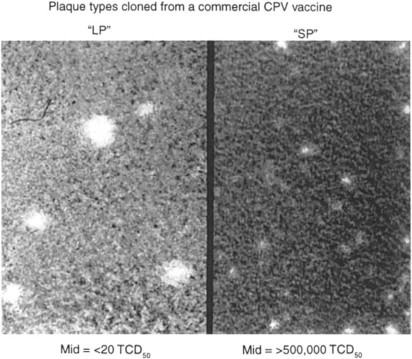犬病毒疫苗的转折点--个人观点。
摘要
最重要的犬病毒感染是犬瘟热和 CPV-2。犬瘟热疫苗的安全性和有效性参差不齐的问题依然存在,但犬瘟热疫苗已大大降低了疾病的流行率,目前接种疫苗的犬已很少发病。犬肝炎(ICH,CAV-1 感染)也已被疫苗很好地控制了 35 年以上,现在已经很少见了;20 世纪 90 年代出现的零星病例通常发生在未接种疫苗的犬身上。因此,应该继续接种 CAV-2 疫苗,因为事实证明这种疫苗安全有效,可以预防肝炎和腺病毒性气管支气管炎。不接种疫苗可能会导致 ICH 病例增加,这是一种严重的疾病,但绝不会像犬瘟热和 CPV 感染那样严重。"我们是否过于频繁地接种疫苗?这个问题很复杂,但主流观点认为 "是"(Smith,1995 年)。不过,这个问题不能明确回答,因为生产商采用的不同菌株免疫能力不同,免疫持续时间也可能不同。这个问题在 20 世纪 60 年代的犬瘟热中经常出现。当时,许多兽医通过向有资质的诊断实验室提供疫苗接种前和接种后的血清来检测他们使用的疫苗批次。这种做法似乎有利于兽医和狗,也有利于疫苗的质量。遗憾的是,许多狗主人和一些兽医似乎认为,只需频繁接种疫苗就能控制副病毒感染等传染病。狗饲养者每年为动物注射数次疫苗的普遍做法是毫无意义的。犬瘟热和细小病毒感染建议在 1 岁时重新接种疫苗,但此后大多数疫苗的接种频率建议尚不明确。由于大多数犬瘟热和 CPV-2 疫苗可能提供持续数年的免疫力,因此在获得更多有关免疫力持续时间的数据之前,在一岁之后每隔 3 到 5 年接种一次疫苗似乎是一种合理的做法。"为狗推广的疫苗种类是否过多?犬瘟热和细小病毒疫苗是必不可少的;我们建议接种犬腺病毒疫苗,因为近年来引起我们注意的少数病例都是未接种疫苗的犬。建议为大多数犬只接种呼吸道感染疫苗,尤其是狗舍中的犬只或寄养的犬只。冠状病毒疫苗的必要性尚未明确确定;莱姆病疫苗(见下文)在有莱姆病的地区对预防疾病很有用,但在其他地区则没有必要,因为狗对适当的抗生素反应很快;目前的钩端螺旋体细菌剂没有任何益处,因为它们所含的血清型在大多数地区都起不到保护作用(见下文)。这里没有考虑莱姆病(LD),但现在有了较新的重组(OspA)疫苗,似乎至少在一年内都是安全有效的,而且它们不会引起疫苗诱发的接种后跛行,而某些全细胞莱姆病细菌疫苗曾有过这样的记录。莱姆病疫苗应仅限于在蜱虫出没的流行地区或进入该地区的犬只接种。85%以上的莱姆病病例发生在大西洋中部和东北部各州,约10%发生在中西部六个州(密歇根州、明尼苏达州和威斯康星州),较小比例发生在加利福尼亚州北部和西北太平洋的限制地区。这里也没有讨论钩端螺旋体病,但疫苗通常被报告为过敏性休克的病因,而且目前的疫苗不含大多数地区流行的血清型。康奈尔大学纽约州诊断实验室诊断出的绝大多数病例都是克氏钩端螺旋体和波莫纳血清型,最近还没有出现由卡尼科拉或冰毒血清型引起的病例。由于钩端螺旋体病是狗的一种重要疾病,因此迫切需要进行更多的研究,并开发出含有流行的钩端螺旋体的更安全的疫苗。

The most important canine viral infections are distemper and CPV-2. Problems of variable CD vaccine safety and efficacy persist, but CD vaccines have greatly reduced the prevalence of disease and cases in vaccinated dogs are now rare. Canine hepatitis (ICH, CAV-1 infection) also has been controlled well by vaccines for more than 35 years and it is now rare; the sporadic cases seen in the 1990s have usually occurred in unvaccinated dogs. CAV-2 vaccines should, therefore, continue to be given since they have proved to be safe and effective, and prevent hepatitis as well as adenoviral tracheobronchitis. Failure to vaccinate would likely result in increase in cases of ICH, a serious disease, but never as significant as distemper and CPV infection. "Are we vaccinating too often?" The question is complex, but the dominant opinion is "yes" (Smith, 1995). The question cannot be responded to unequivocally, however, since manufacturers employ different strains that vary in their immunizing capacity and, probably, duration of immunity. This question was frequent with distemper in the 1960s. At that time, many veterinarians tested batches of the vaccine they used by providing pre- and postvaccinal sera to competent diagnostic laboratories. That practice appeared to benefit veterinarians and dogs, as well as the quality of vaccines. Unfortunately, many owners and some veterinarians seem to hold the view that infectious diseases such as parvovirus infection can be controlled by frequent vaccination alone. The common practice of dog breeders of vaccinating their animals several times each year is senseless. Revaccination for distemper and parvovirus infection is suggested at 1 year of age, but recommendations regarding the frequency of most vaccinations given after that time are unclear. Since most distemper and CPV-2 vaccines probably provide immunity that endures several years, vaccination at 3- to 5-year intervals, after the first year, seems a reasonable practice until more data on duration of immunity become available. "Are too many kinds of vaccines being promoted for dogs?" Distemper and parvovirus vaccines are essential; canine adenovirus vaccines are recommended since the few cases brought to our attention in recent years have been in unvaccinated dogs. Vaccination against respiratory infections is recommended for most dogs, especially those in kennels, or if they are to be boarded. Need has not been clearly established for coronavirus vaccines; Lyme disease vaccines (see below) are useful in preventing illness in areas where the disease exists, but are unnecessary elsewhere since dogs respond rapidly to appropriate antibiotics; current Leptospira bacterins are without benefit since they contain serovars that fail to protect in most areas (noted below). Lyme disease (LD) was not considered here, but newer recombinant (OspA) vaccines are now available that appear to be safe and effective for at least 1 year and they have not caused vaccine-induced postvaccinal lameness, which has been documented with certain whole-cell Lyme disease bacterins. Lyme disease vaccines should be restricted to dogs in, or entering, endemic areas where infested ticks reside. More than 85% of LD cases occur in the mid-Atlantic and Northeastern States, about 10% in six Midwestern states (Michigan, Minnesota, and Wisconsin), and a smaller percentage in restricted areas of northern California and the Pacific Northwest. Leptospirosis also was not discussed here, but vaccines are commonly reported as a cause of anaphylaxis and current vaccines do not contain the serovars prevalent in most regions. The vast majority of cases diagnosed at the New York State Diagnostic Lab at Cornell are grippotyphosa and pomona serovars and there have been no recent cases caused by canicola or icterohemorrhagiae serovars. Because leptospirosis is an important disease of dogs, there is an urgent need for more research and the development of safer vaccines that contain the prevalent

 求助内容:
求助内容: 应助结果提醒方式:
应助结果提醒方式:


